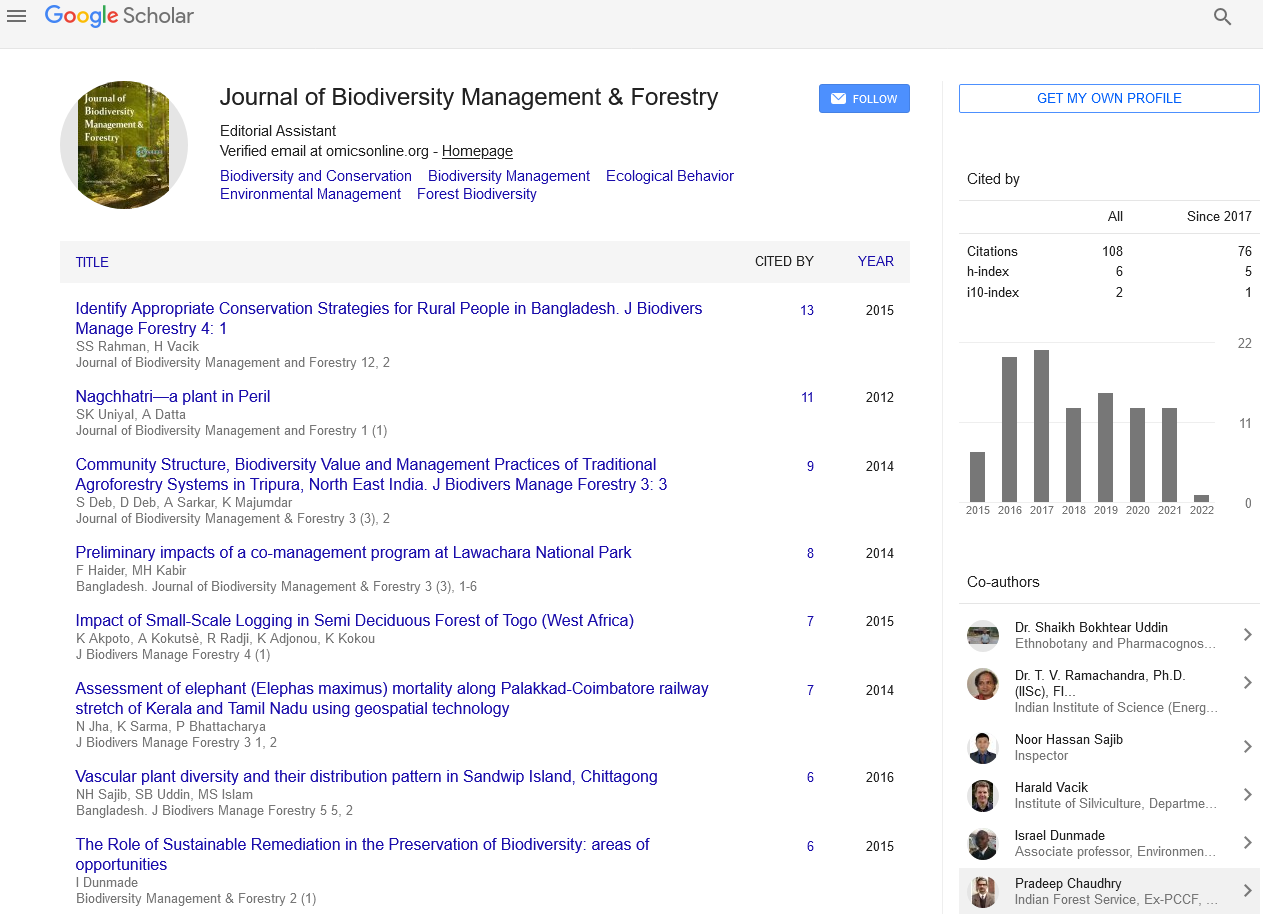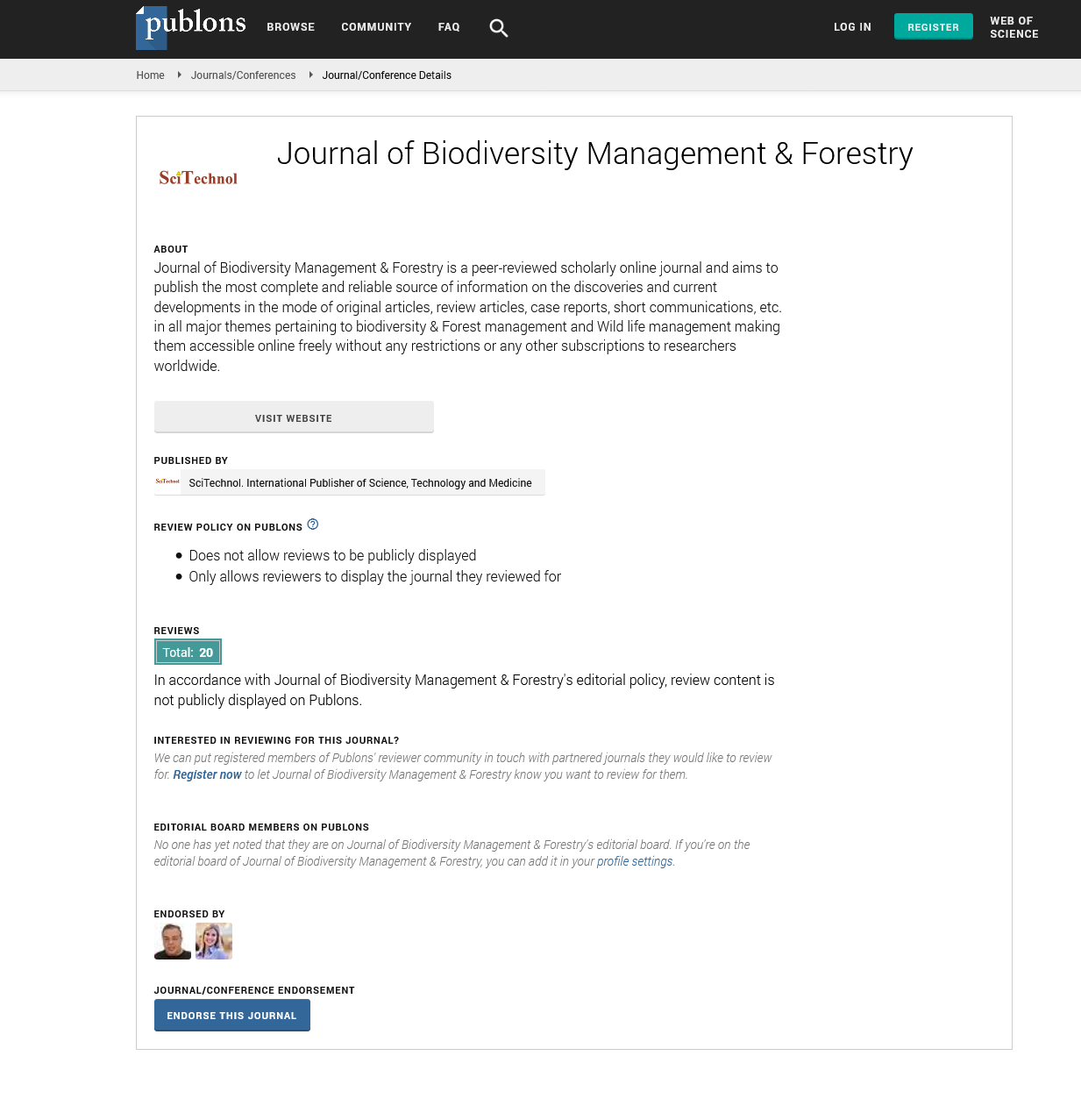Commentary, J Biodivers Manage Forestry Vol: 12 Issue: 5
Monitoring Nature's Recovery: The Role of Evaluation in Restoration
Ralpha Der*
1Department of Environmental Engineering Sciences, University of Florida, Gainesville, USA
*Corresponding Author: Ralpha Der,
Department of Environmental Engineering Sciences, University of
Florida, Gainesville, USA
E-mail: ralpha.der@uu.nl
Received date: 28 November, 2023, Manuscript No. JBMF-23-123683;
Editor assigned date: 30 November, 2023, Pre QC No. JBMF-23-123683 (PQ);
Reviewed date: 15 December, 2023, QC No. JBMF-23-123683;
Revised date: 22 December, 2023, Manuscript No. JBMF-23-123683 (R);
Published date: 29 December, 2023, DOI: 10.4172/jbmf 2327-4417.1000063
Citation: Der R (2023) Monitoring Nature's Recovery: The Role of Evaluation in Restoration. J Biodivers Manage Forestry 12:5.
Description
Restoration ecology is a multidisciplinary field that aims to repair, renew, and rehabilitate ecosystems that have been degraded, damaged, or altered by human activities or natural events. The principles and practices of restoration ecology provide a framework for guiding ecological restoration projects. These projects focus on returning ecosystems to a more natural and sustainable state, promoting biodiversity, and enhancing ecosystem services. In this exploration, we will delve into the key principles and practices that guide restoration ecology.
Restoration projects begin with the establishment of clear goals and objectives. These may include biodiversity conservation, habitat rehabilitation, soil stabilization, or the restoration of ecosystem services. Setting specific and measurable goals helps guide the entire restoration process. Before initiating restoration efforts, it is crucial to understand the historical conditions of the ecosystem. Historical data, including information on native species composition, habitat structure, and ecosystem dynamics, provide a baseline for restoration targets. Native species are adapted to local environmental conditions and play a crucial role in ecosystem functioning. Restoration projects prioritize the use of native plants and animals to recreate a balanced and resilient ecological community.
Ecological succession is the natural process of change in ecosystems over time. Restoration projects often imitate or accelerate ecological succession to guide the development of restored ecosystems. Understanding successional processes helps predict and manage changes over time. Genetic diversity within species is essential for the resilience of ecosystems. Restoration efforts consider the use of genetically diverse plant and animal populations to enhance adaptability and increase the chances of long-term success. Effective restoration goes beyond treating symptoms and addresses the underlying causes of ecosystem degradation. This may involve changes in land management practices, policies, or human behaviors that contribute to ecosystem decline. Ecosystems are dynamic, and uncertainties exist in the success of restoration projects. Adaptive management involves a flexible and iterative approach, allowing for adjustments based on monitoring, evaluation, and learning from both successes and failures.
Habitat fragmentation is a common challenge in restoration ecology. Ensuring connectivity between restored and existing habitats is crucial for the movement of species, gene flow, and overall ecosystem resilience. Successful restoration projects involve collaboration with local communities, landowners, and other stakeholders. Engaging these groups fosters a sense of ownership, ensures local knowledge is considered, and promotes the long-term sustainability of restoration efforts. The first step in a restoration project is a thorough assessment of the site. This includes understanding the current ecological conditions, identifying the causes of degradation, and collecting baseline data on soil, water, and vegetation. Based on the site assessment, restoration practitioners develop a comprehensive ecological plan. This plan outlines restoration goals, identifies target species, and proposes specific actions to achieve the desired ecological outcomes.
Invasive species can pose significant challenges to ecosystem restoration by outcompeting native species. Effective restoration involves the control or removal of invasive species to create space for the recovery of native vegetation. Soil health is critical for the success of restoration projects. Practices such as erosion control, nutrient management, and soil amendment may be employed to improve soil conditions and support plant establishment. Planting native vegetation is a common practice in restoration projects. This may involve direct seeding, transplanting, or using container-grown plants. The selection of appropriate species and planting methods depends on site conditions and restoration goals. Wetlands are often targeted for restoration due to their ecological importance. Techniques such as regrading, controlling water flow, and planting wetland vegetation are employed to restore the structure and function of degraded wetland ecosystems. Riparian zones along rivers and streams are critical habitats. Restoration efforts in riparian areas may include planting native vegetation, stabilizing banks, and addressing factors contributing to erosion and degradation. Regular monitoring is essential to assess the progress of restoration projects. This involves tracking changes in vegetation, wildlife, soil conditions, and other relevant parameters. Evaluation helps determine the effectiveness of restoration strategies and informs adaptive management.
 Spanish
Spanish  Chinese
Chinese  Russian
Russian  German
German  French
French  Japanese
Japanese  Portuguese
Portuguese  Hindi
Hindi 
